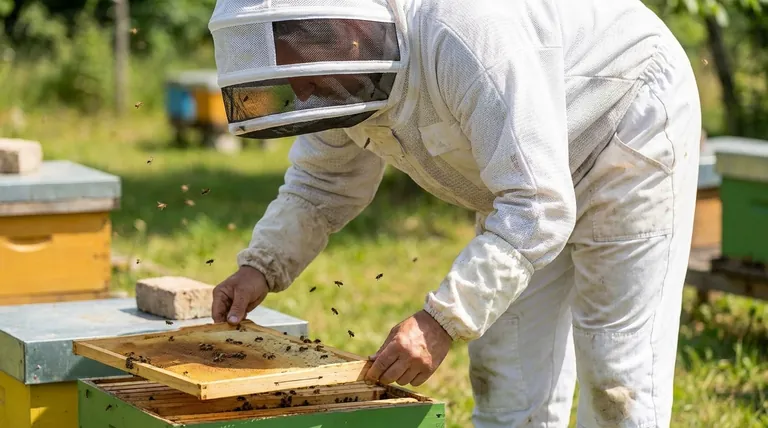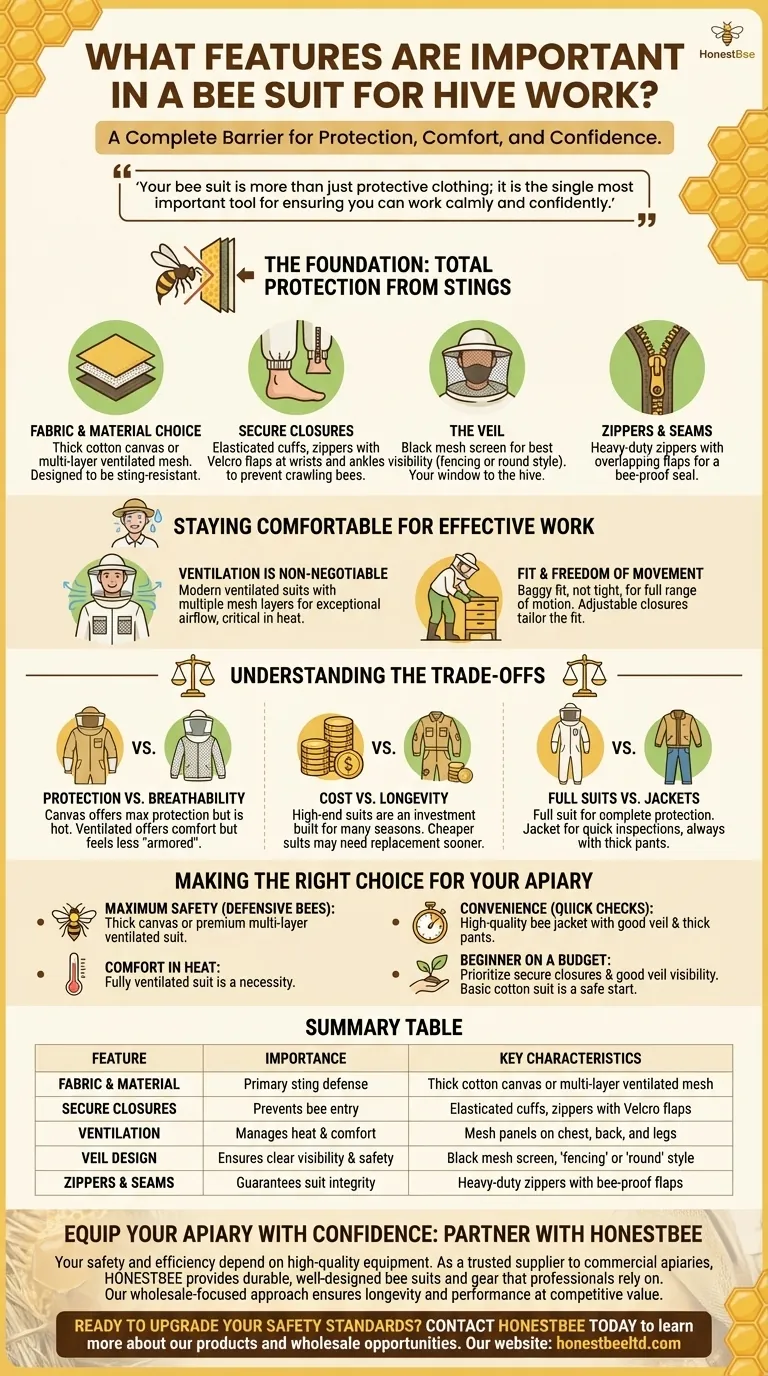The most important features of a bee suit are those that create a complete barrier against stings while ensuring you remain comfortable and cool. Key elements include durable, sting-resistant fabric, secure closures at all entry points like wrists and ankles, effective ventilation for heat management, and a well-designed veil that provides clear visibility.
Your bee suit is more than just protective clothing; it is the single most important tool for ensuring you can work calmly and confidently. The ideal suit isn't just about preventing stings, but about managing heat and maintaining mobility so you can focus on the health of your hive.

The Foundation: Total Protection from Stings
A bee suit's primary function is to prevent stings. This is achieved not by a single feature, but by a system of overlapping components working together.
Fabric and Material Choice
The fabric is your first line of defense. A bee's stinger needs to penetrate the material and still have enough length to reach your skin.
Thick cotton canvas or multi-layer ventilated mesh are the industry standards. They are designed to be thick enough that a stinger cannot reach you, even if it penetrates the outer layer.
Secure Closures: The Weakest Link
Bees are master crawlers and will exploit any gap. Cuffs and ankles are the most common entry points.
Look for strong elasticated cuffs at the wrists and ankles. High-quality suits will often add zippers at the ankles to make them easier to pull over boots, with a Velcro flap covering the zipper for added security.
The Veil: Your Window to the Hive
Your ability to see clearly is critical for working safely and effectively. The veil is arguably the most important component of the suit.
Most modern suits use a black mesh screen, as it offers the best visibility and reduces glare compared to lighter colors. There are two primary styles: the "fencing" veil, which is structured away from your face, and the "round" veil, which offers a wider field of view.
Zippers and Seams
A cheap zipper can fail at the worst possible moment. Look for heavy-duty zippers, often made of brass or durable plastic. The best suits feature overlapping flaps that cover the zippers, creating a bee-proof seal.
Staying Comfortable for Effective Work
Being protected is essential, but if you are miserably hot, you will rush your work and make mistakes. Comfort is a key part of safety.
Ventilation is Non-Negotiable
Overheating is a significant risk for beekeepers, leading to fatigue, dehydration, and poor decision-making.
Modern ventilated suits are a game-changer, especially in warmer climates. They use multiple layers of mesh fabric that allow for exceptional airflow while maintaining sting protection. Look for large vented panels on the chest, back, and even down the legs.
Fit and Freedom of Movement
A bee suit should be baggy, not tight. When fabric is stretched taut against your skin, it becomes much easier for a bee's stinger to penetrate.
A loose fit also allows for a full range of motion, so you can bend, lift, and work without feeling restricted. Adjustable closures can help tailor the fit, but always err on the side of a larger size.
Understanding the Trade-offs
No single suit is perfect for every beekeeper in every situation. You must balance competing priorities.
Protection vs. Breathability
This is the classic trade-off. A thick, heavy-duty cotton canvas suit offers maximum peace of mind and protection but can be incredibly hot.
A fully ventilated suit provides superior comfort in the heat but may feel less "armored" to a new beekeeper. Both are highly effective, but your climate is the deciding factor.
Cost vs. Longevity
High-end suits with robust zippers, reinforced knees, and full ventilation are an investment. They are built to last for many seasons.
Less expensive suits can provide adequate protection, but they often compromise on features like zipper quality, seam durability, and ventilation. This can lead to frustration or the need for a replacement sooner than you expect.
Full Suits vs. Jackets
A full suit offers complete, head-to-toe protection and is the recommended choice for beginners and anyone doing intensive hive work.
A bee jacket is convenient for very quick inspections and is easier to put on and take off. However, it leaves your legs vulnerable and should always be paired with thick, light-colored pants. It is not recommended for beginners or for working with defensive colonies.
Making the Right Choice for Your Apiary
Select your gear based on your specific environment and beekeeping style.
- If your primary focus is maximum safety with defensive bees: Choose a thick, non-vented canvas or a premium multi-layer ventilated suit with overlapping zipper guards.
- If your primary focus is comfort in a hot climate: A fully ventilated suit is not a luxury; it is a necessity for safe and enjoyable beekeeping.
- If your primary focus is convenience for quick hive checks: A high-quality bee jacket with a good veil can be sufficient, but never neglect wearing thick pants and proper boots.
- If you are a beginner on a budget: Prioritize secure closures at the wrists and ankles and a veil with good visibility. A basic cotton suit with these features is a safe starting point.
Ultimately, the right gear empowers you to be a calm, confident, and effective beekeeper.
Summary Table:
| Feature | Importance | Key Characteristics |
|---|---|---|
| Fabric & Material | Primary sting defense | Thick cotton canvas or multi-layer ventilated mesh |
| Secure Closures | Prevents bee entry | Elasticated cuffs, zippers with Velcro flaps at wrists and ankles |
| Ventilation | Manages heat and comfort | Mesh panels on chest, back, and legs for airflow |
| Veil Design | Ensures clear visibility and safety | Black mesh screen, 'fencing' or 'round' style |
| Zippers & Seams | Guarantees suit integrity | Heavy-duty zippers with overlapping, bee-proof flaps |
Equip Your Apiary with Confidence: Partner with HONESTBEE
Your safety and efficiency in the hive depend on high-quality, reliable equipment. As a trusted supplier of beekeeping supplies and equipment to commercial apiaries and distributors, HONESTBEE provides the durable, well-designed bee suits and protective gear that professional beekeepers rely on.
We understand the demands of commercial operations. Our wholesale-focused approach ensures you get the protective gear you need, built for longevity and performance, at a competitive value.
Ready to upgrade your apiary's safety standards? Let's discuss your specific needs.
Contact HONESTBEE today to learn more about our products and wholesale opportunities.
Visual Guide

Related Products
- Cotton Beekeeping Suit and Round Hat with Veil Bee Keeper Protective Gear
- Beekeeping Jacket with Hood and Veil for Beekeepers
- Professional Beekeeping Suit for Kids and Girls Childrens Bee Keeper Suit
- White Beekeeping Protective Suit and Hat with Fencing Veil for Beekeepers
- Beekeeper Cowboy Hat and Veil for Beekeeping
People Also Ask
- How should a bee suit be cleaned? Protect Your Investment and Ensure Apiary Safety
- Why is white the predominant color in bee suit designs? | Key to Hive Calm & Beekeeper Safety
- Why is a jacket with a hat veil recommended for beekeepers? Essential Protection for Your Face and Neck
- What is recommended for beginners in beekeeping regarding protective clothing? A Complete Safety Guide for New Beekeepers
- How should a beekeeping suit be hung to maintain its shape? Protect Your Investment with Proper Storage



















